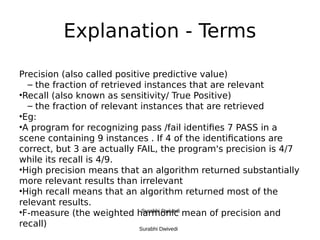Statistical terms for classification
- 1. Statistical terms for Classification in weka Surabhi Dwivedi
- 2. Important Statistics to select a model •Confusion Matrix •TP Rate •FP Rate •Precision •Recall •F-measure •ROC Area •Kappa Statistics •Test Option for Classifier – Cross Validation – Supplied test set – Percentage split Surabhi Dwivedi
- 3. Confusion Matrix • In machine learning, a confusion matrix, also known as a contingency table or an error matrix –A table layout that allows visualization of the performance of an algorithm –Each column of the matrix represents the instances in a predicted class –Each row represents the instances in an actual class Surabhi Dwivedi
- 5. Sample
- 8. Explanation - Terms Precision (also called positive predictive value) – the fraction of retrieved instances that are relevant •Recall (also known as sensitivity/ True Positive) – the fraction of relevant instances that are retrieved •Eg: •A program for recognizing pass /fail identifies 7 PASS in a scene containing 9 instances . If 4 of the identifications are correct, but 3 are actually FAIL, the program's precision is 4/7 while its recall is 4/9. •High precision means that an algorithm returned substantially more relevant results than irrelevant •High recall means that an algorithm returned most of the relevant results. •F-measure (the weighted harmonic mean of precision and recall) Surabhi Dwivedi Surabhi Dwivedi
- 9. Explanation - Terms Precision (also called positive predictive value) – the fraction of retrieved instances that are relevant •Recall (also known as sensitivity/ True Positive) – the fraction of relevant instances that are retrieved •Eg: •A program for recognizing pass /fail identifies 7 PASS in a scene containing 9 instances . If 4 of the identifications are correct, but 3 are actually FAIL, the program's precision is 4/7 while its recall is 4/9. •High precision means that an algorithm returned substantially more relevant results than irrelevant •High recall means that an algorithm returned most of the relevant results. •F-measure (the weighted harmonic mean of precision and recall) Surabhi Dwivedi
- 10. F-score •In statistical analysis of binary classification, the F-score or F-measure –a measure of a test's accuracy. –It considers both the precision p and the recall r of the test to compute the score –a weighted average of the precision and recall –an F1 score reaches its best value at 1 and worst score at 0 Surabhi Dwivedi
- 12. Kappa Statistics •Kappa is a chance-corrected measure of agreement between the classifications and the true classes. – A value of 1 implies perfect agreement and values less than 1 imply less than perfect agreement • Poor agreement = Less than 0.20 • Fair agreement = 0.20 to 0.40 • Moderate agreement = 0.40 to 0.60 • Good agreement = 0.60 to 0.80 • Very good agreement = 0.80 to 1.00 •Kappa statistic - a mean for evaluating the predication performance of classifiers – gives a better indicator of how the classifier performed across all instances Surabhi Dwivedi
- 13. Kappa Statistics •The row indicates the true class, the column indicates the Actu al Predicted
- 14. ROC Curve •ROC curve, is a graphical plot that illustrates the performance of a binary classifier system as its discrimination threshold is varied. •The curve is created by plotting the true positive rate against the false positive rate at various threshold settings. •The true-positive rate is also known as sensitivity or recall in machine learning. The false-positive rate is also known as the fall-out and can be calculated as 1 - specificity. •Specificity (sometimes called the true negative rate) measures the proportion of negatives which are correctly identified as such (e.g., the percentage of healthy people who are correctly identified as not having the condition), and is complementary to the false positive rate. Surabhi Dwivedi
- 16. Receiver Operating Curve – Class XII Data Sample
- 17. Receiver Operating Curve – Class X Data Sample
- 18. ROC Curve Sample
- 19. •In ROC curve, a better model is more towards upper left corner. •Output – Threshold Curve Surabhi Dwivedi
- 20. Margin Curve •The margin curve prints the cumulative frequency of the difference of actual class probability and the highest probability predicted for other classes •for a single class, if it is predicted to be positive with probability p, the margin is p - (1-p) =2p-1. •The negative values denote classification errors, meaning that the dominant class is not the correct one •Margin contains the margin value (plotted as an x- coordinate) •Cumulative contains the count of instances with margin less than or equal to the current margin (plot as y axis) Surabhi Dwivedi
- 24. Test Options - Classifier •The test sets are a percentage of the data that will be used to test whether the model has learned the concept properly •In WEKA you can run an execution splitting your data set into training data (to build the tree in the case of J48) and test data (to test the model in order to determine that the concept has been learned). Surabhi Dwivedi
- 25. Thank you
























